The United States faces a foundational challenge: the pursuit of leadership in artificial intelligence, industrial regeneration, and domestic manufacturing depends not only on digital infrastructure or intellectual capital — but on the physical availability of critical materials. Strategic goals are constrained by resource realities. Without a reliable supply of metals, the foundation of technological and industrial progress, growth is limited. Mining comes first.
This poses a fundamental policy issue. The United States cannot realistically pursue its economic rebalancing initiatives without committing to the restoration of domestic mining capacity and securing long-term access to mineral reserves.
Yet, years of underinvestment in the mining sector have left the nation increasingly reliant on foreign sources for strategic materials. This growing dependence exposes the US to geopolitical risks and fragile supply chains. Today’s system is ill-equipped to meet current metals demand, let alone the surge expected from AI development, defense modernization, and advanced manufacturing.
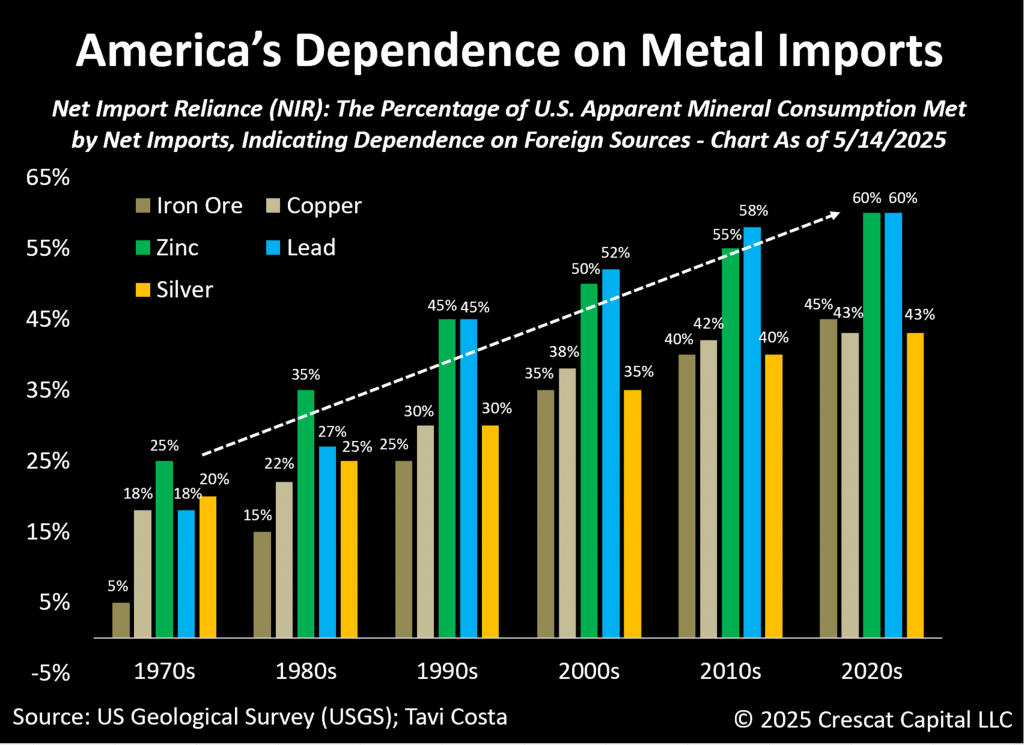
Mining Was 20% of GDP — Now It’s a Rounding Error
A stark indicator of this decline is the erosion of private fixed investment in mining as a share of the overall economy. Over the past several decades, the US mining sector has contracted dramatically: fixed asset investment in mining now accounts for a mere 0.3% of GDP, a precipitous drop from nearly 20% in the mid-20th century.
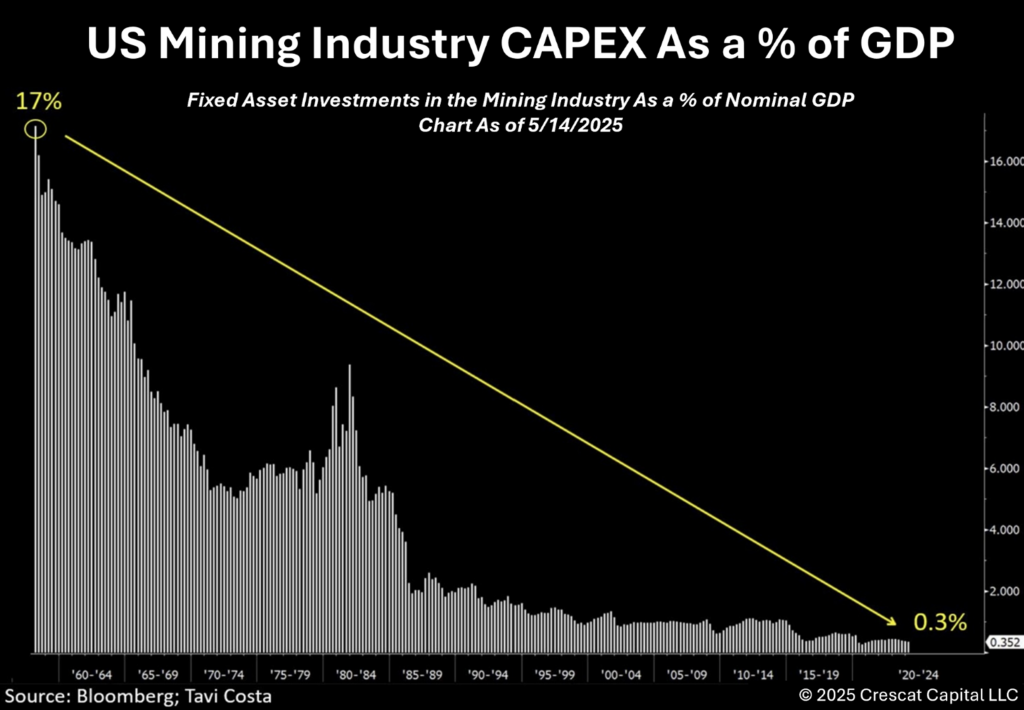
Building the House Before Laying the Foundation
This shift reflects a broader historical trend. Over the 20th century, the US transitioned from being largely self-sufficient in metals and minerals to becoming heavily dependent on imports. In the early 1900s, the US was a global powerhouse and net exporter of critical metals with domestic mining meeting nearly all national demand.
However, as industrial growth accelerated mid-century, compounded by World War II demands and rising domestic production costs, imports steadily increased. By the latter half of the century, import shares for critical metals surpassed 50%, driven by declining domestic mining capacity, globalization, environmental regulations, and foreign competition.
Entering the 21st century, the US became heavily reliant on imports for many critical minerals, some sourced entirely from abroad. This dependence on countries like China has heightened concerns about supply chain vulnerabilities and national security, as domestic mining struggles to keep pace with the growing demand essential to manufacturing, technology, energy, and defense.
Against this backdrop, the advancement of robotics and artificial intelligence depends fundamentally on access to raw materials — especially metals. This is not a “chicken-or-egg” question; the order is clear. These technologies cannot be developed or deployed at scale without the physical inputs needed to build them.
Metals are the backbone of the hardware that enables AI and robotics, as well as the expansion of the electrical grid and broader infrastructure. Without a reliable supply, the full potential of technological progress cannot be achieved.
While some argue that we have enough critical metals like copper, this often refers to total underground resources and reserves—not what’s currently accessible or ready for use. According to S&P Global, it takes an average of 16.2 years for a copper project to go from discovery to production, including 4 to 12 years for development and another 1.5 to 2.5 years for construction.
Given these long timelines, new mining projects for copper and other essential metals must be planned and initiated well ahead of any major technological rollout. Ambitious infrastructure and clean energy goals will remain theoretical unless backed by the materials needed to build them. Without sufficient above-ground supply, the pace of innovation will ultimately be limited by the availability of critical resources.
The reality is that we’re building the house before laying the foundation.
We believe electricity demand is poised to surge beyond anything seen in recent decades — yet the US and global economies remain far from securing the raw materials needed to support this wave of technological expansion.
What needs to be emphasized, however, is that this initial surge — powered by the rapid expansion of data centers, a revival in domestic manufacturing, and new electrification efforts — is just the beginning of what appears to be a far larger, unstoppable shift that will transform the energy and industrial landscape, in our view.
The scale-up in growth compared to recent decades is profound and poses an impossible challenge to the nation’s aging grid infrastructure, which cannot accommodate such a rapid increase.
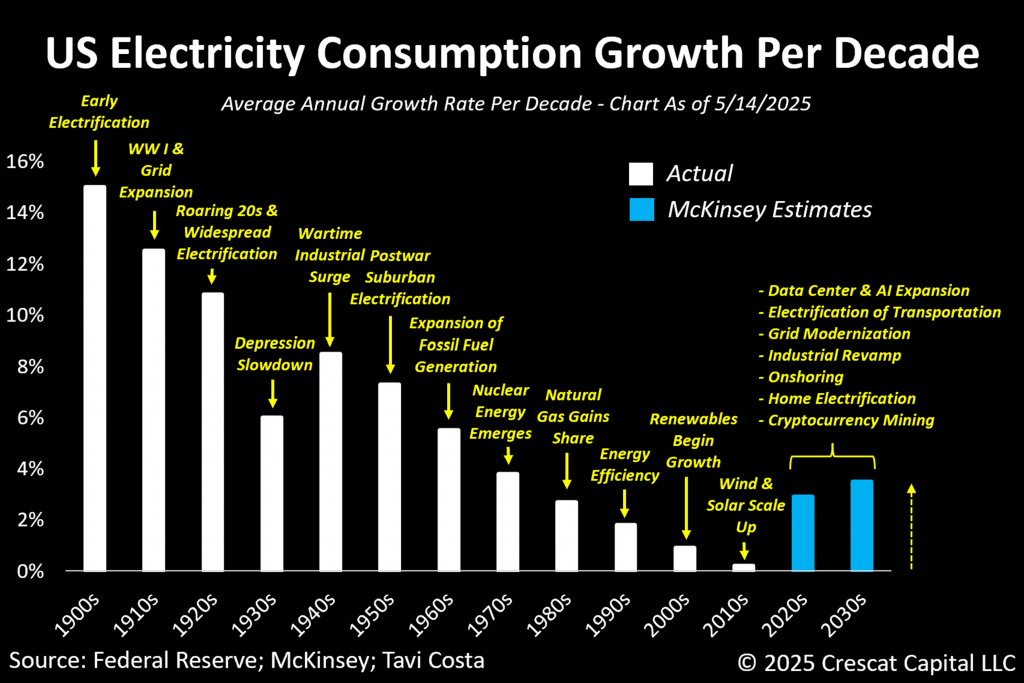
Lights Out: The Black Swan Lurking in the Grid
While it may appear alarmist, the likelihood of a major disruption in electricity availability over the next five years is a risk that should not be underestimated. Such a development could have systemic implications, comparable to a black swan event for global markets. Current efforts are heavily concentrated on the rapid expansion of data centers, and to a lesser extent, on increasing energy generation.
Additionally, consider the chart below — arguably one of the most critical issues policymakers must address. It points to a looming and highly complex challenge:
According to AI prodigy, Leopold Aschenbrenner, the global economy is on pace to add electricity demand equivalent to the entire current consumption of the United States within just five years due to AI computing requirements.
This new demand has yet to be accommodated in the current planned increase in global power generation capacity. Aschenbrenner’s back-of-the-envelope math was endorsed by Elon Musk via his liking and re-posting of this chart on X.
Equally significant is the sustained upward trend in Chinese electricity demand, a consequence of its role as the world’s manufacturing hub. If the US is to pursue meaningful industrial onshoring efforts, this, plus the AI demand, will further amplify domestic electricity requirements over the next five years compared to the mere trendline extensions in the chart.
This raises a fundamental question: where will this additional electricity come from? While some may point to nuclear energy as a long-term solution, and to natural gas, solar, and coal in the short term, an equally pressing issue remains: do we have the on-grid and off-grid infrastructure needed to deliver and support this growing demand?
Yet the most critical question rarely asked is this: do we have the supply of critical metals necessary to enable these vital changes?
And to be clear, this means metals not just buried underground, but those available above ground and ready for use — without multi-decade delays.
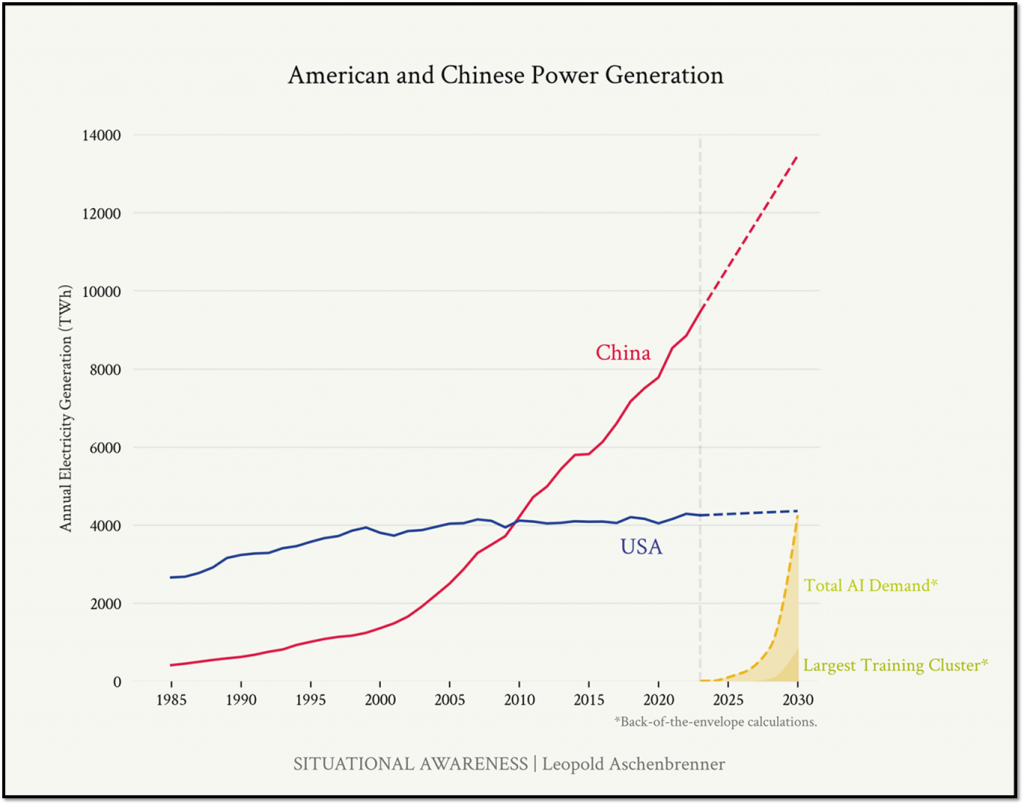
Nurture the Miners, Fuel the Future
The Global Investor Commission on Mining 2030 recently emphasized the urgency of this challenge, highlighting that at least $1.5 trillion in capital investment will be needed globally over the next five years to sustainably and responsibly expand mining capacity.
To put this into perspective, the entire global mining sector currently has a market capitalization of only $2.2 trillion — meaning the required investment is almost equivalent to the entire industry’s current value.
This mismatch is further illustrated in the chart below, which shows that mining accounts for only about 1% of the global equity market. Historically, the sector occupied a much larger share relative to the broader market.
The current underrepresentation signals a fundamental misalignment — and highlights the urgent need for renewed attention, capital, and long-term support for the mining industry.
Without it, the foundation for future economic growth, including technological and energy progress, remains on uncertain ground.
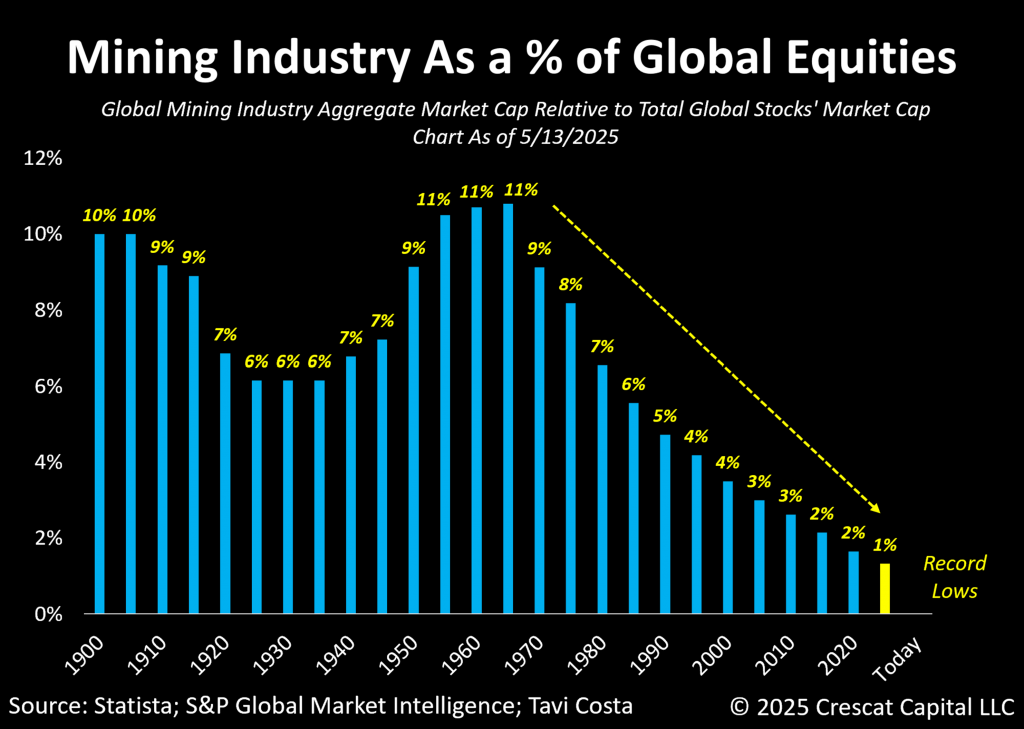
Rebuild the Mining Labor Force
Sometimes, a crisis is necessary to spark human ingenuity—and we believe we are on the verge of one.
This problem extends well beyond capital investment or permitting reforms. It is a deep structural issue, primarily caused by a severe shortage of specialized technical expertise in geology, metallurgy, mining engineering, and environmental science. Despite its importance, very few people today understand and appreciate the complexities involved in mining.
It seems we’ve lost sight of a simple truth: before we code the future, we have to dig for it.
From a macro perspective, we have already seen the early signs of tightening metal inventories. In many cases, what appears to be market oversupply can flip to structural undersupply within months. This is particularly true across several key metals, where above-ground inventories are historically low and demand trajectories are accelerating. Yet despite rising prices, investment in new supply remains tepid — a reflection of regulatory complexity, permitting delays, and chronic underappreciation of mining’s strategic value among investment allocators.
The labor force needed to build, operate, and develop mining assets continues to decline. We see this industry as becoming completely neglected — both financially and culturally — at precisely the time it should be viewed as a national priority.
Mining underpins not only economic growth but national security, energy resilience, and technological sovereignty. This is not a peripheral issue; it is a core societal challenge, both in the United States and globally, that must be addressed.
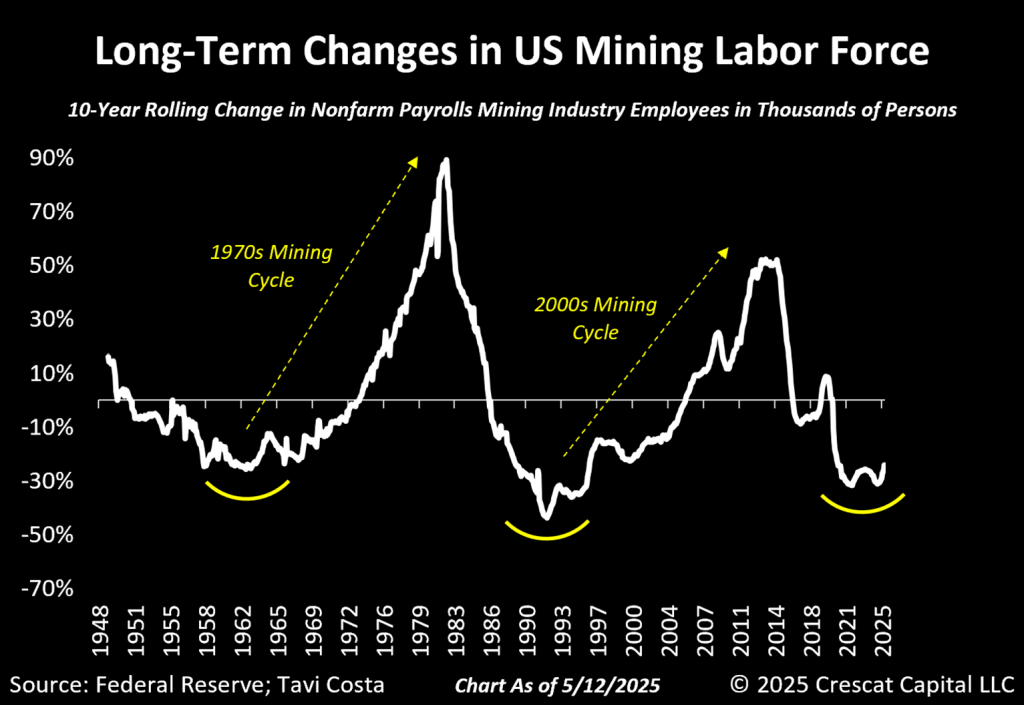
Mining Is a Necessity, Not a Choice
The mining industry finds itself at the center of a growing imbalance — an unresolved supply-demand mismatch that should increasingly attract capital out of necessity, not just discretion. Within this context, we regard activist investing in exploration and mining as a highly compelling thematic investment opportunity.
There are times in our lives when conviction meets preparedness. We believe long-standing market inefficiencies created by passive index investing trends have created a significant fundamental industry-wide re-rate opportunity. A legacy industry at historically undervalued prices has just been deemed strategic and critical by the US executive administration as part of its grand economic and geopolitical rebalancing agenda.
Our investment thesis in mining is further grounded in the likelihood of an extended period of rising hard asset prices. Given the current global macro environment — characterized by historically high debt levels and limited fiscal flexibility — the probability of financial repression as a policy outcome, we believe, is high. Whether occurring organically or through deliberate policy choices, a regime of suppressed interest rates and elevated inflation expectations tends to be conducive to the outperformance of hard assets. In this setting, the strategic importance of the mining sector is likely to become increasingly difficult to ignore.
Charts like the one below highlight the significant discrepancies we see in today’s market. For example, despite generating free cash flow comparable to Apple, the entire energy sector is valued at less than half the market cap of the world’s second-largest company — one that has reported essentially flat revenue growth over the past three years.
The disconnect becomes even more striking when looking at the mining industry: Apple is currently valued at 11 times the combined market cap of the entire US mining sector. These are truly astonishing comparisons.
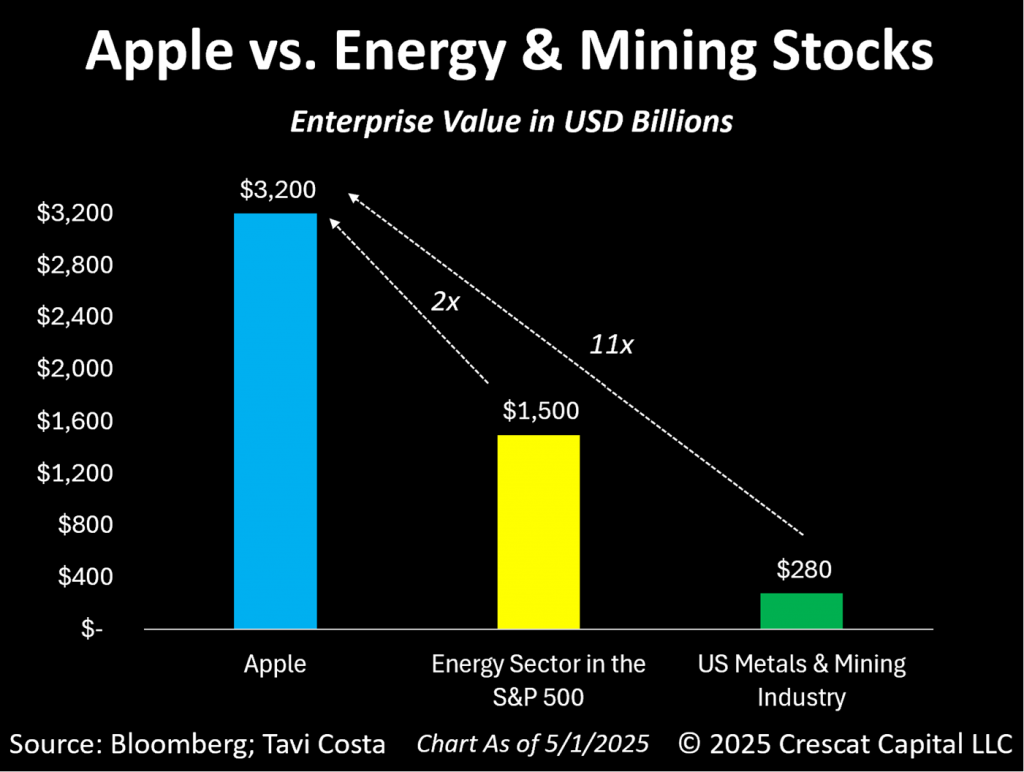
Crescat may or may not invest in the securities discussed here. Investing involves risk, including the risk of loss.
The Best Ideas Start Unloved
Following one of the most substantial upward moves in the price of gold in recent history, we argue that the next logical phase of the macro cycle may involve the relative outperformance of assets historically correlated with gold — namely, mining equities and other metals. Investor sentiment toward the mining sector remains markedly negative, particularly with respect to exploration and development companies. This prevailing skepticism echoes the prior dismissal of gold itself, when it was derided by many as a non-productive “relic” asset.
Investor sentiment toward earlier-stage mining companies remains stubbornly pessimistic — almost irrationally so — despite senior miners operating with some of the highest margins we have seen in decades. The liquidity generated at the top of the mining industry is likely to trickle down to high-quality companies with undeveloped assets.
Many large producers are facing stalled revenue growth due to limited resource expansion, making it logical to expect capital to eventually flow to the next tier of mining companies — those that historically outperform when the capital cycle turns in their favor.
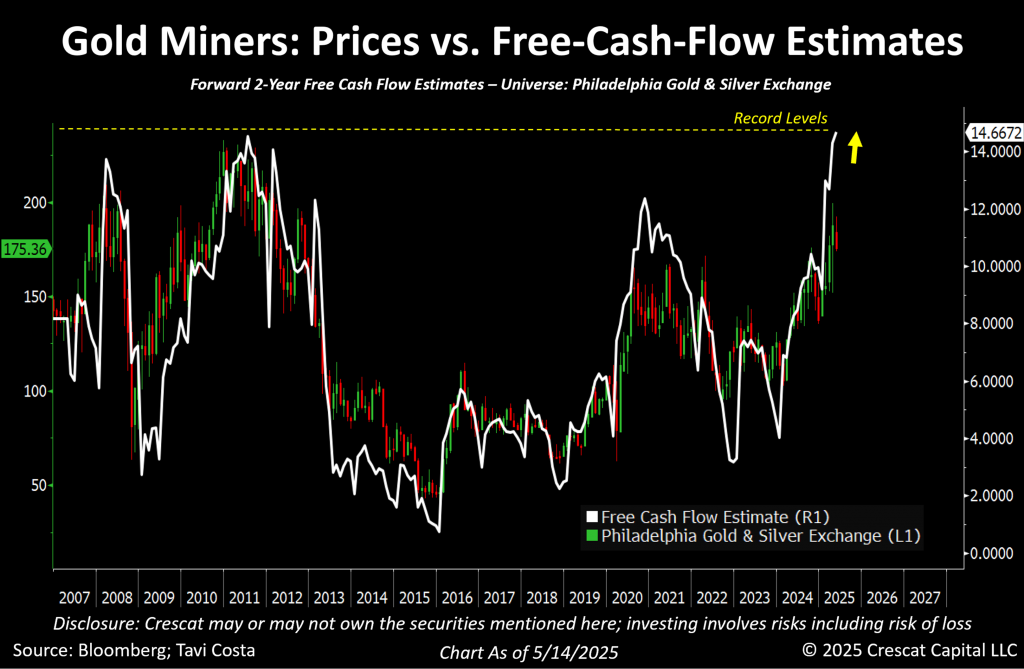
The Trickle-Down Effect
Importantly, mining companies have a unique financial characteristic: as commodity prices rise, the in-ground value of their reserves appreciates, thereby expanding their balance sheets without requiring additional capital investment.
This embedded optionality is not yet fully reflected in market valuations, in our view.
While senior mining companies are already experiencing margin expansion, particularly in gold operations, this profitability has not yet translated into broader interest in the earlier-stage segment of this industry. Historical precedent suggests this is a temporary condition.
Capital cycles in the mining sector tend to follow a predictable pattern. During early phases of commodity price increases, senior producers benefit disproportionately. As their profitability improves, these companies — often facing stagnant reserve bases — begin to allocate capital toward acquisition or joint ventures with smaller developers. This process represents a natural liquidity transmission from large-cap to small-cap miners, and it often results in significant revaluations of junior companies with high-quality, undeveloped assets.
This transition is typically accompanied by an influx of generalist investors attempting to rapidly gain fluency in a highly complex and specialized industry. The mining sector demands multidisciplinary expertise in geology, engineering, environmental regulation, and jurisdictional risk, among other fields.
Consequently, those with long-standing involvement and deep technical insight may be best positioned to capitalize on what is likely to be the early stages of this capital rotation.
We strongly believe that Crescat, with its experienced team and activist engagement in its portfolio, is among the select few investment managers with the expertise to succeed in what we view as one of the most important upcoming mining cycles in the industry’s history.
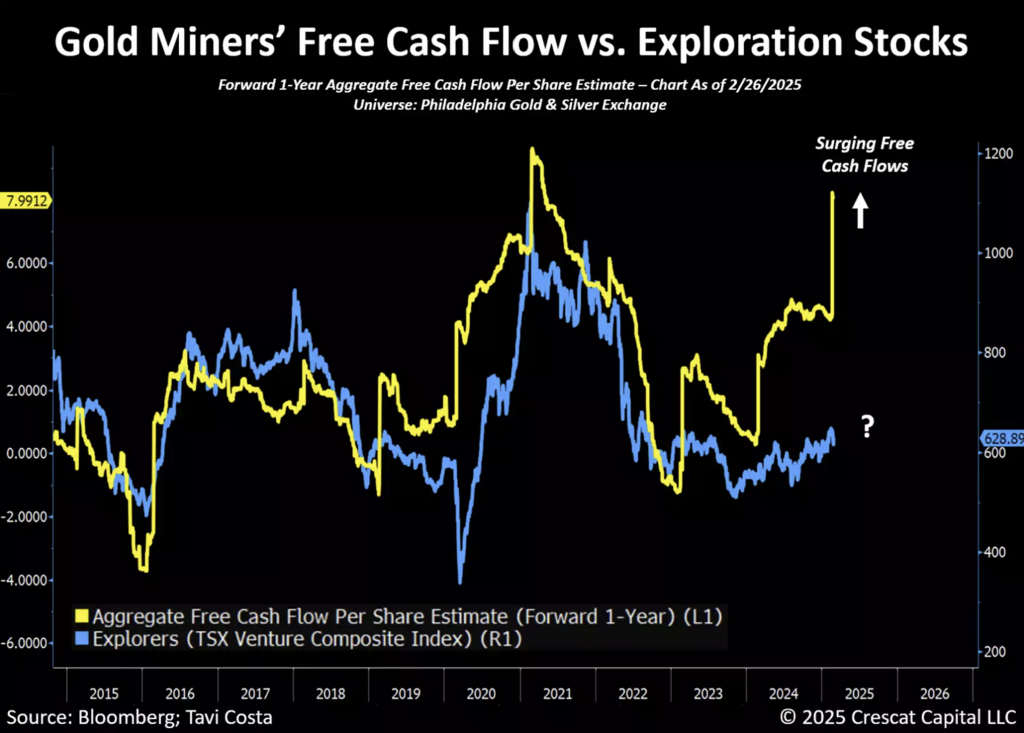
Same Cycle, New Wrapping
The gold-to-silver ratio, when examined through a historical lens, reveals a pattern of mean reversion that has persisted for over a century. Periods in which the ratio exceeds the 100 level have historically been rare and short-lived, suggesting that such extremes are unlikely to be sustained over time. Based on historical precedent, the current environment does not appear conducive to a structurally bearish outlook on silver.
Investors are faced with a choice: either accept the premise that “this time is different” or maintain confidence in long-standing historical patterns. Our position firmly aligns with the latter.
There is no precedent for the gold-to-silver ratio remaining above 100 for an extended period, and we see limited justification for anticipating a further breakout before a reversion occurs. On the contrary, this setup presents what we view as one of the most compelling opportunities in the current macro environment — akin to the asymmetry found in select mining equities, in our opinion.
More broadly, natural resource assets appear significantly undervalued by historical standards. When priced in gold, most commodities — not just silver — are trading near multi-decade lows. This dislocation reflects the early stages of a structural shift in how markets assess monetary and fiscal sustainability.
This shift also helps explain the growing emphasis on gold accumulation at the sovereign level, as governments begin to reassess the role of sound money in addressing today’s mounting monetary challenges.
The next phase of this cycle may be marked by aggressive policy responses to rising debt burdens, including the forced suppression of interest rates. Such actions could entail leadership changes at central banks, new monetary policy frameworks designed to anchor rates at lower levels, increased regulatory pressure on financial institutions and monetary authorities to absorb sovereign debt, or even international coordination to support US Treasuries.
The range of potential policy tools is vast, and the willingness to use them may be greater than markets currently anticipate.
Crucially, the artificial suppression of interest rates is unlikely to benefit only gold. When monetary policy becomes increasingly constrained and real yields are driven lower, the resulting capital flows tend to favor a wide range of tangible assets.
Current market dynamics already reflect the early signs of this shift. In our view, the conditions are rapidly aligning for a broad-based revaluation across the commodity space — and we are nearing that turning point.
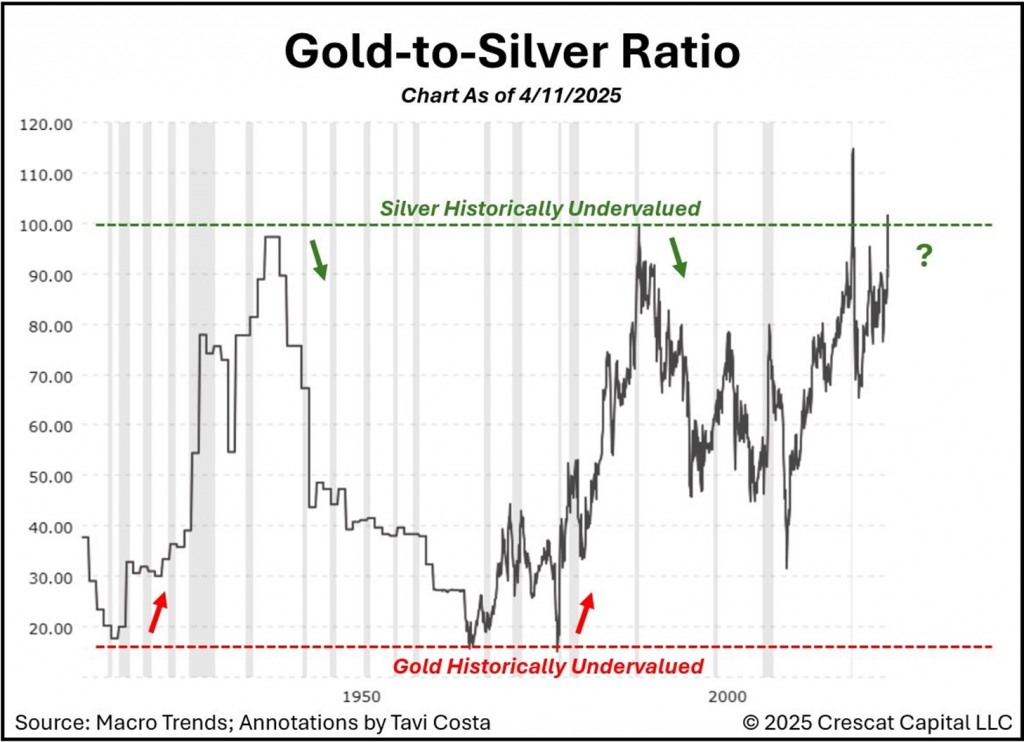
Beyond Gold: The Rise of a Broad Commodity Cycle
The energy sector is also likely to participate meaningfully in the broader commodity revaluation we anticipate. Historical precedent supports this view — notably, oil played a leading role in the commodities bull market of the 1970s. We believe that, ultimately, all natural resource markets stand to benefit from the current macro backdrop, which is characterized by structurally unsustainable debt levels, declining real interest rates, and rising geopolitical fragmentation.
What makes oil and natural gas particularly noteworthy in this context is their extreme short-term supply inelasticity relative to demand. Inventories above ground can shift rapidly due to demand shocks, and markets have historically transitioned from oversupply to acute shortages in a matter of weeks. This dynamic becomes especially important in a world where nations are increasingly turning inward, seeking to reduce reliance on global trade and traditional energy alliances. In our view, oil prices today have largely shed their geopolitical risk premium — a condition that is unlikely to persist indefinitely given growing deglobalization trends.
More critically, when examining relative valuations, the gold-to-oil ratio highlights a profound dislocation. Today’s levels are among the most extreme in history, second only to a brief episode during the 2020 crisis.
This has significant implications for metal producers. For open-pit mining operations — where energy costs can represent up to 30% of total expenditures — the current spread between metal and energy prices is highly favorable, translating into exceptional operating margins.
However, such asymmetries are rarely long-lasting. We would emphasize that this may be a timely opportunity for producers to consider hedging energy exposure, as mean reversion in these relative price relationships has historically followed quickly and with force.
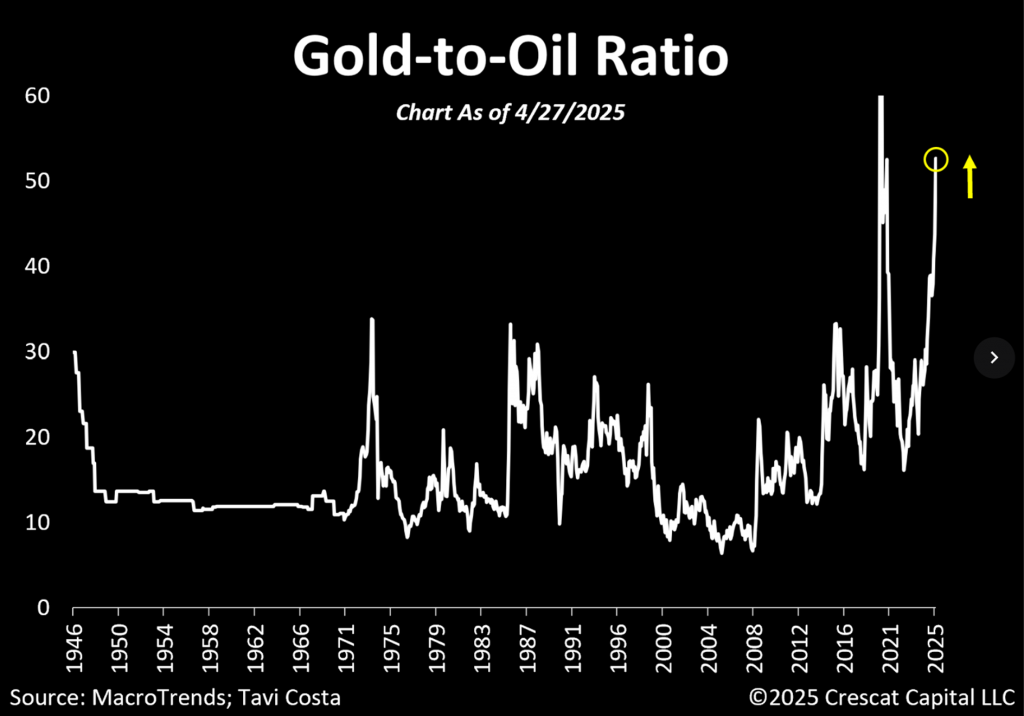
The US Dollar: The Cornerstone of Financial Markets
Commodity bull markets have historically coincided with periods of sustained US dollar weakness. While these currency cycles often take time to materialize, once in motion, they tend to persist for years. We believe the current environment is setting up for a similar trajectory, with the US dollar likely to face continued depreciation against other major currencies.
While many attempt to overcomplicate the drivers behind these trends, the fundamental issue is straightforward:
The US is grappling with an interest expense burden approaching 5% of GDP — the highest among developed economies. To address this growing imbalance, policymakers will likely default to a familiar response: loosening monetary policy while simultaneously pursuing some degree of fiscal restraint.
Historically, this policy mix has created a persistently negative backdrop for the US dollar.
Compounding this situation is the current administration’s dual focus: aggressively pursuing lower interest rates and attempting to reverse long-standing trade imbalances.
It is important to recognize that no nation improves its trade position with an overvalued currency — a weaker dollar is a necessary component of this strategy.
Further underscoring this direction are recent remarks from Treasury Secretary Scott Bessent, who stated, “If China starts devaluing, that’s a tax on others.” In our view, this reflects a clear and coordinated policy stance: the US is increasingly focused on weakening its currency as a tool of economic management.
Given this macro landscape, we believe investors should prepare for a prolonged period of dollar weakness and position accordingly.
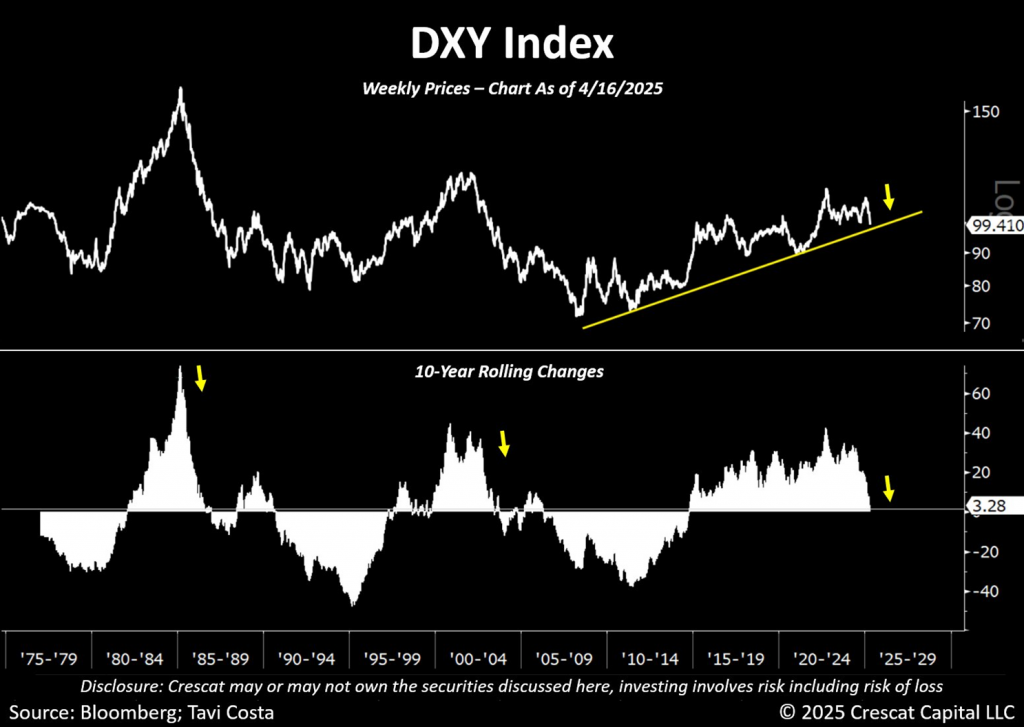
Miners’ Rally: A Harbinger of Dollar Weakness
The historical relationship between gold miners and the Japanese yen is both compelling and underappreciated. While this dynamic isn’t exclusive to the yen — similar correlations exist with other dollar currency pairs — the broader point remains: these assets often move in tandem.
Once gold enters a bull market, miners typically lead the charge, followed by a broader wave of beneficiaries, including foreign currencies that tend to appreciate as the dollar weakens. Although the yen has begun to strengthen recently, it still lags well behind the performance of gold mining stocks.
We saw a similar pattern in the mid-2000s, when miners surged first, and fiat currencies — particularly the yen — followed with a significant appreciation a year or two later.
Today, that setup may be even more extreme, in our view. On a trade-weighted basis, the US dollar remains near its most overvalued level in more than 120 years, creating what could be an even stronger tailwind for miners and foreign currencies alike.
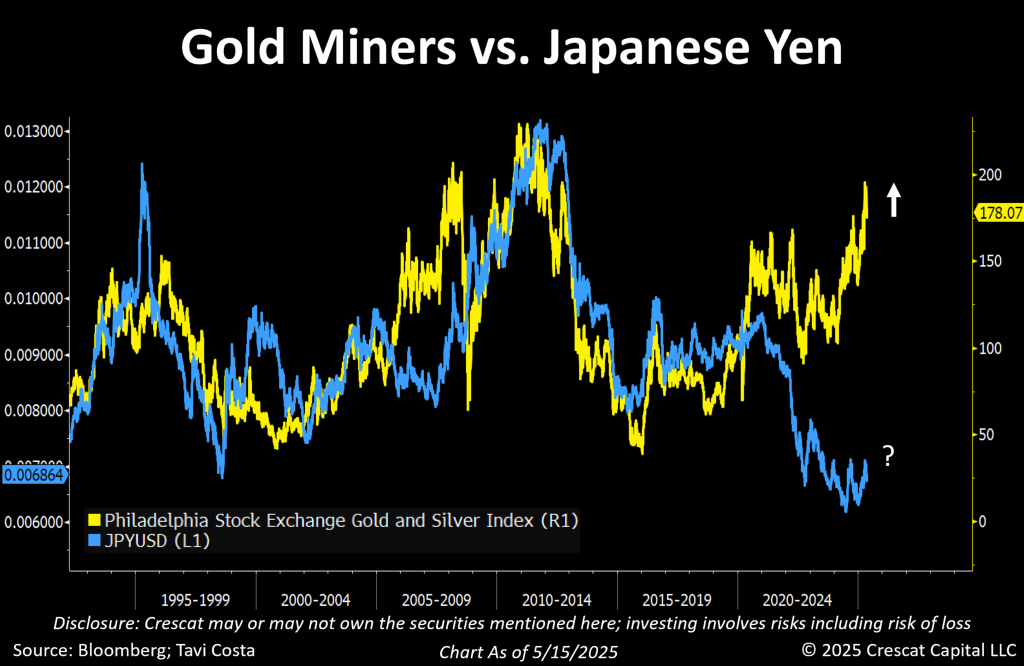
The Era of Hard Assets Begins
It is noteworthy how recently gold and other metals have performed well, even during broad-based stock market selloffs. This has happened in past periods characterized by extreme debt imbalances were the path of least resistance toward deleveraging typically involves lowering interest rates while allowing inflation to run above trend — whether through natural market forces or deliberate policy intervention.
Such conditions tend to create a highly favorable environment for hard assets. In our view, this dynamic is still in its early stages.
A sustained decline in the US dollar, in our view, could carry significant implications for global financial markets. Historically, there has been a clear inverse relationship between the dollar’s long-term trajectory and the commodities-to-equities ratio. When the dollar enters a structural downtrend, empirical evidence shows that commodities and other hard assets tend to outperform US equities by a wide margin.
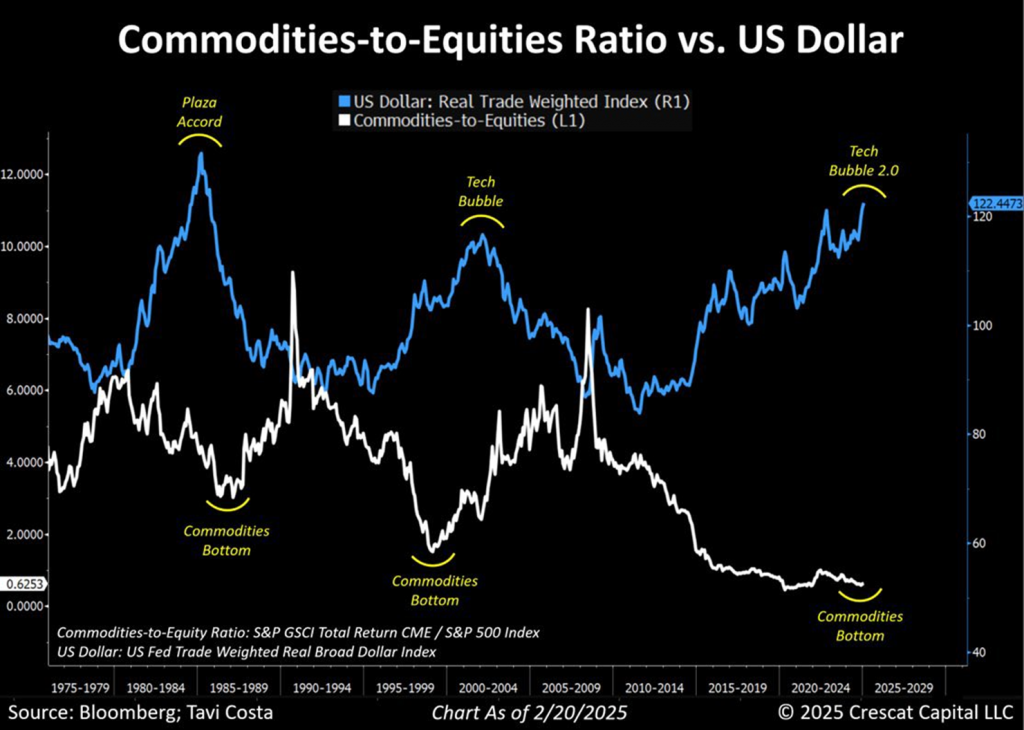
The Path to a Major Rebalancing
As we listened to Scott Bessent speak at the Institute of International Finance (IIF) Global Outlook Forum a few weeks ago, one word stood out: “rebalancing.” He used it six times in reference to economic policy and global trade. But what immediately came to mind was a very different kind of rebalancing — the one long-overdue in global financial markets.
Specifically, we’re referring to the extreme concentration of capital in US equities relative to the rest of the world. This imbalance remains one of the most glaring distortions across global asset allocation. It’s the real “elephant in the room” that continues to go largely under-addressed.
Ironically, efforts to correct one economic distortion often set another in motion. That dynamic may well be at play here.
In our view, the most significant shift still ahead is a structural rebalancing within equity markets themselves — away from US dominance and toward broader global participation.
A prolonged period of US dollar weakness, combined with capped long-term interest rates, would provide precisely the backdrop needed for international equities and hard assets to begin meaningfully outperforming US stocks.
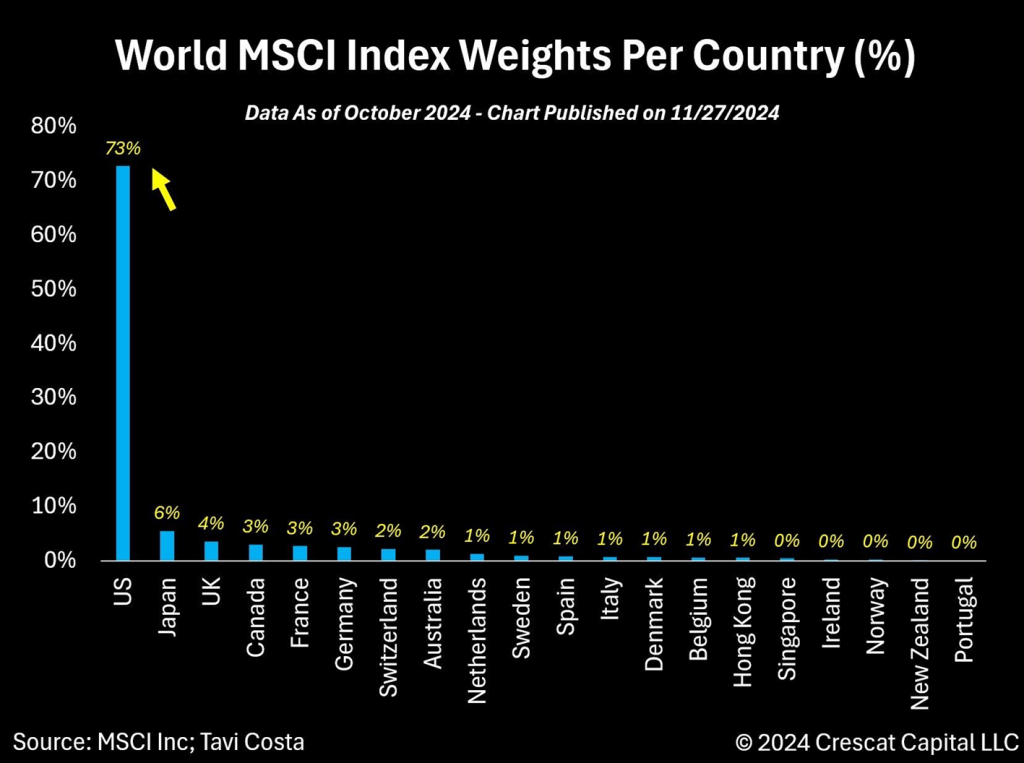
Unlocking the Latin America Opportunity
Finally, the chart below offers a powerful illustration of the kind of decade we may be entering.
The historical cycle of performance between U.S. and Latin American equities is well documented — though often overlooked. Market leadership between these regions has consistently rotated over time: some periods favor the U.S., while others see Latin America take the lead.
We’ve just experienced one of the most extended stretches of U.S. outperformance relative to Latin American markets in history. At some point, that trend reverses. The two primary factors that typically deter investors from emerging markets — a strong U.S. dollar and rising interest rates — now appear to be fading. As those headwinds subside, the conditions may finally be aligning for a meaningful influx of capital into emerging markets.
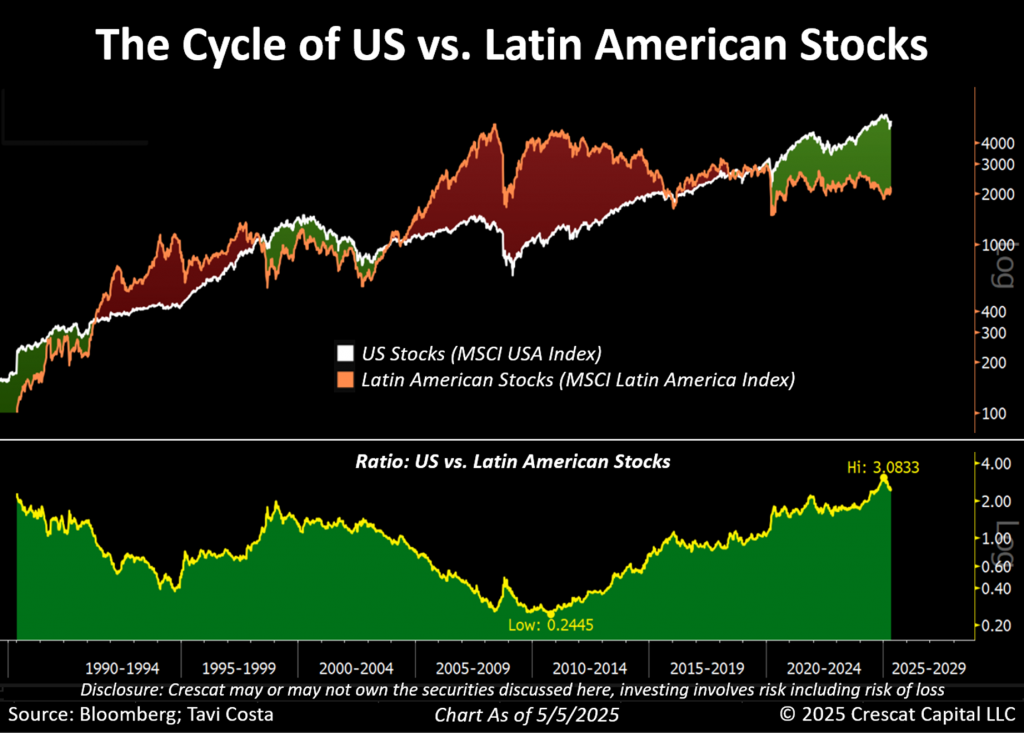
Crescat Precious Metals Fund Performance Since Inception vs. Benchmarks

Please see important disclosures regarding this chart below. 6
Performance Year to Date
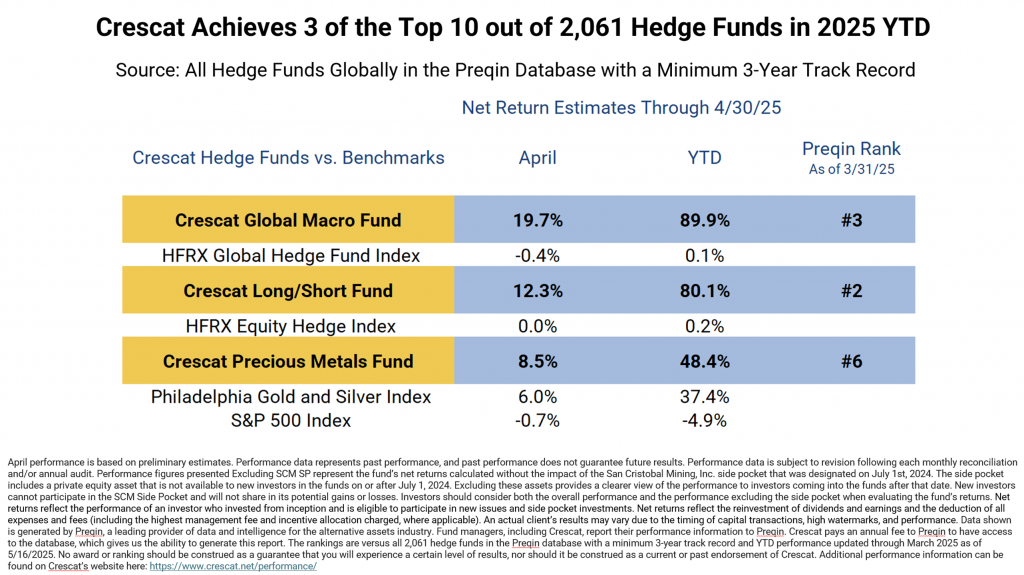
Performance Since Inception, All Crescat Funds
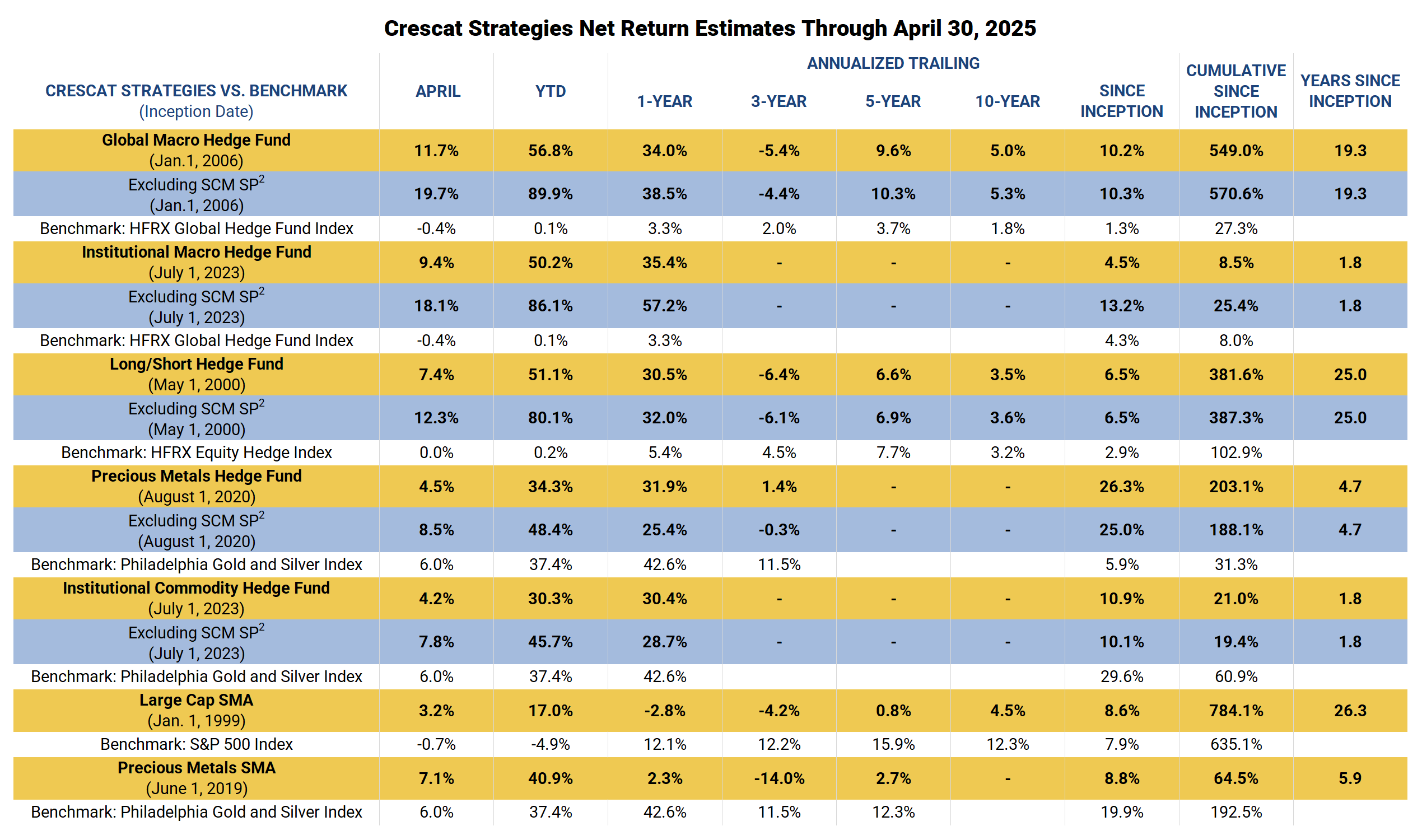
Please see important disclosures regarding this chart below.
We are excited about the opportunities in the markets ahead and encourage you to reach out to any of us listed below if you would like to learn more about how our investment vehicles might fit with your individual needs and objectives.
Sincerely,
Kevin C. Smith, CFA
Founding Member & Chief Investment Officer
Tavi Costa
Member & Macro Strategist
Quinton T. Hennigh, PhD
Member & Geologic and Technical Advisor
For more information, including how to invest, please contact:
Marek Iwahashi
Head of Investor Relations
miwahashi@crescat.net
(720) 323-2995
Linda Carleu Smith, CPA
Co-Founding Member & Chief Operating Officer
lsmith@crescat.net
(303) 228-7371
© 2025 Crescat Capital LLC
Important Disclosures
Discussion and details provided are for informational purposes only. This letter is not intended to be, nor should it be construed as, an offer to sell or a solicitation of an offer to buy any security, services of Crescat, or its Funds. The information provided in this letter is not intended as investment advice or recommendation to buy or sell any type of investment, or as an opinion on, or a suggestion of, the merits of any particular investment strategy. This letter may contain certain forward-looking statements, opinions and projections that are based on the assumptions and judgments of Crescat with respect to, among other things, future economic, competitive and market conditions and future business decisions, all of which are difficult or impossible to predict accurately and many of which are beyond the control of Crescat. Because of the significant uncertainties inherent in these assumptions and judgments, you should not place undue reliance on these forward looking statements, nor should you regard the inclusion of these statements as a representation by Crescat that these objectives will be achieved.
CPM has not sought or obtained consent from any third party to use any statements or information indicated herein that have been obtained or derived from statements made or published by such third parties.
All content posted on CPM’s letters including graphics, logos, articles, and other materials, is the property of CPM or others and is protected by copyright and other laws.
Performance
Performance data represents past performance, and past performance does not guarantee future results. Performance data, including Estimated Performance, is subject to revision following each monthly reconciliation and/or annual audit. Individual performance may be lower or higher than the performance data presented. The currency used to express performance is U.S. dollars. Before January 1, 2003, the results reflect accounts managed at a predecessor firm. Crescat was not responsible for the management of the assets during the period reflected in those predecessor performance results. We have determined the management of these accounts was sufficiently similar and provides relevant performance information.
1 – Net returns reflect the performance of an investor who invested from inception and is eligible to participate in new issues and side pocket investments. Net returns reflect the reinvestment of dividends and earnings and the deduction of all expenses and fees (including the highest management fee and incentive allocation charged, where applicable). An actual client’s results may vary due to the timing of capital transactions, high watermarks, and performance.
2 – Performance figures presented, excluding SCM SP, represent the fund’s net returns calculated without the impact of the San Cristobal Mining, Inc. side pocket that was designated on July 1st, 2024. The side pocket includes a private equity asset that is not available to new investors in the funds on or after July 1, 2024. Excluding these assets provides a clearer view of the performance to investors coming into the funds after that date. New investors cannot participate in the SCM Side Pocket and will not share in its potential gains or losses. Investors should consider both the overall performance and the performance excluding the side pocket when evaluating the fund’s returns.
3 – The SMA composites include all accounts that are managed according to CPM’s precious metals or large cap SMA strategy over which it has full discretion. Investment results shown are for taxable and tax-exempt accounts. Any possible tax liabilities incurred by the taxable accounts are not reflected in net performance. Performance results are time weighted and reflect the deduction of advisory fees, brokerage commissions, and other expenses that a client would have paid, and includes the reinvestment of dividends and other earnings.
4 – Data shown is generated by Preqin, a leading provider of data and intelligence for the alternative assets industry. Fund managers, including Crescat, report their performance information to Preqin. Crescat pays an annual fee to Preqin to have access to the database, which gives us the ability to generate this report. The rankings are versus all 873 hedge funds in the Preqin database with a minimum 3-year track record and YTD performance updated through March 2025 as of 4/25/2025. No award or ranking should be construed as a guarantee that you will experience a certain level of results, nor should it be construed as a current or past endorsement of Crescat.
5 – The activist metals portfolio subset consists of firmwide holdings across all Crescat funds and SMA accounts in the mining industry where Crescat strives to help companies build economic metal resources through exploration and drilling. Crescat provides capital and geologic guidance to help companies build resources across Crescat’s activist portfolio.
Crescat target resource estimates are based on internal modeling performed by Crescat’s Geologic and Technical Director, Quinton T. Hennigh, PhD and include various assumptions based on his analysis of geology, geophysics, geochemistry, historic drill assays, and metallurgical recovery data received to date. Target resource estimates are discounted based on drilling progress to date, an assessment of the management and technical team’s strengths and weaknesses affecting their ability to advance the project, and environmental, local community, and government permitting risk factors. Estimates are displayed on a gold equivalent basis based on current price-to-gold ratios for silver, copper, and other metals if the primary metal is other than gold. Further drilling, assaying, resource modeling, and engineering studies will be required to determine whether Crescat’s target resource estimates can be reasonably expected to be achieved. Crescat’s target resource estimates are updated monthly across the entire portfolio.
The number of active drills includes the number of drills currently in operation doing exploration and/or infill drilling or expected to be deployed over the next twelve months based on each company’s drilling plans and Crescat’s assessment of the company’s ability to finance and execute those plans.
6 Performance estimates through April 30th, 2025. *Performance figures presented represent the fund’s net returns calculated without the impact of the San Cristobal Mining, Inc. (SCM) Side Pocket that was designated on July 1st, 2024. The SCM Side Pocket includes a private equity asset that is not available to new investors in the funds on or after July 1, 2024. This asset was included in the fund performance prior to that date. Excluding the SCM Side Pocket after that date provides a clearer view of the performance to investors coming into the funds after July 1, 2024. New investors cannot participate in the SCM Side Pocket and will not share in its potential gains or losses. Investors should consider both the overall performance and the performance excluding the side pocket when evaluating the fund’s returns. Fund performance, including the SCM Side Pocket, can be found on the firm’s website here:https://www.crescat.net/performance/. Returns for the most recent month are based on internal estimates which have the potential to change once finalized. Additional disclosures regarding risks and performance presented are found here:https://www.crescat.net/due-diligence/disclosures/
Benchmarks
PHILADELPHIA STOCK EXCHANGE GOLD AND SILVER INDEX. The PHLX Gold/Silver Sector Index (XAU) is a capitalization-weighted index composed of companies involved in the gold or silver mining industry. The Index began on January 19, 1979.
S&P 500 INDEX. The S&P 500® is widely regarded as the best single gauge of large-cap U.S. equities. The index includes 500 leading companies and covers approximately 80% of available market capitalization.
S&P Select Industry Indices are designed to measure the performance of narrow GICS® sub-industries. The Metals and Mining Select Industry Index comprises stocks in the S&P Total Market Index that are classified in the GICS Aluminum, Coal & Consumable Fuels, Copper, Diversified Metals & Mining, Gold, Precious Metals & Mining, Silver and Steel sub-industries.
References to indices, benchmarks or other measures of relative market performance over a specified period of time are provided for your information only. Reference to an index does not imply that the fund or separately managed account will achieve returns, volatility or other results similar to that index. The composition of an index may not reflect the manner in which a portfolio is constructed in relation to expected or achieved returns, portfolio guidelines, restrictions, sectors, correlations, concentrations, volatility or tracking.
Hedge Fund disclosures: Only accredited investors and qualified clients will be admitted as limited partners to a CPM hedge fund. For natural persons, investors must meet SEC requirements including minimum annual income or net worth thresholds. CPM’s hedge funds are being offered in reliance on an exemption from the registration requirements of the Securities Act of 1933 and are not required to comply with specific disclosure requirements that apply to registration under the Securities Act. The SEC has not passed upon the merits of or given its approval to CPM’s hedge funds, the terms of the offering, or the accuracy or completeness of any offering materials. A registration statement has not been filed for any CPM hedge fund with the SEC. Limited partner interests in the CPM hedge funds are subject to legal restrictions on transfer and resale. Investors should not assume they will be able to resell their securities. Investing in securities involves risk. Investors should be able to bear the loss of their investment. Investments in CPM’s hedge funds are not subject to the protections of the Investment Company Act of 1940.
Those who are considering an investment in the Funds should carefully review the relevant Fund’s offering memorandum and the information concerning CPM. For additional disclosures including important risk disclosures and Crescat’s ADV please see our website: https://www.crescat.net/due-diligence/disclosures/